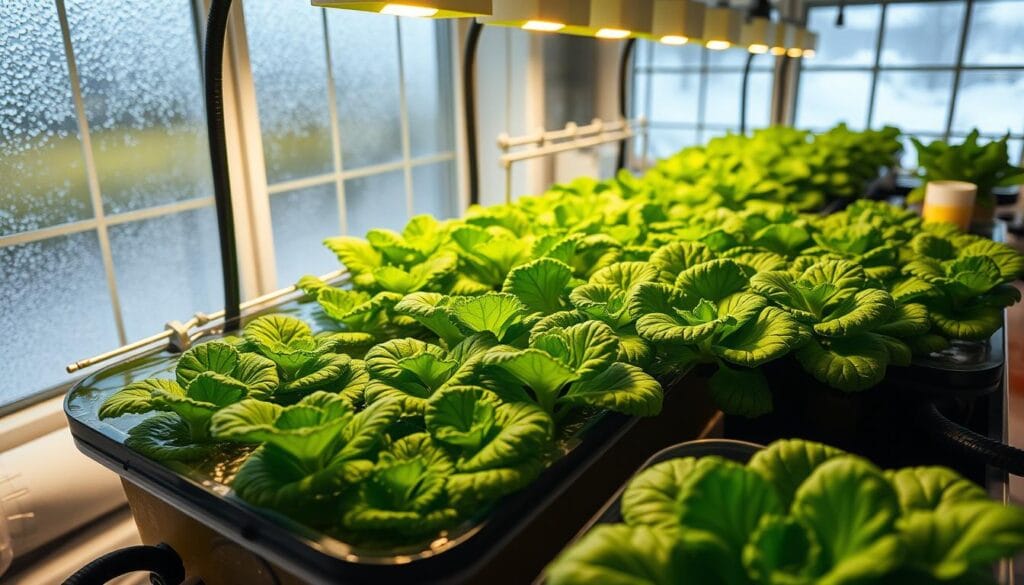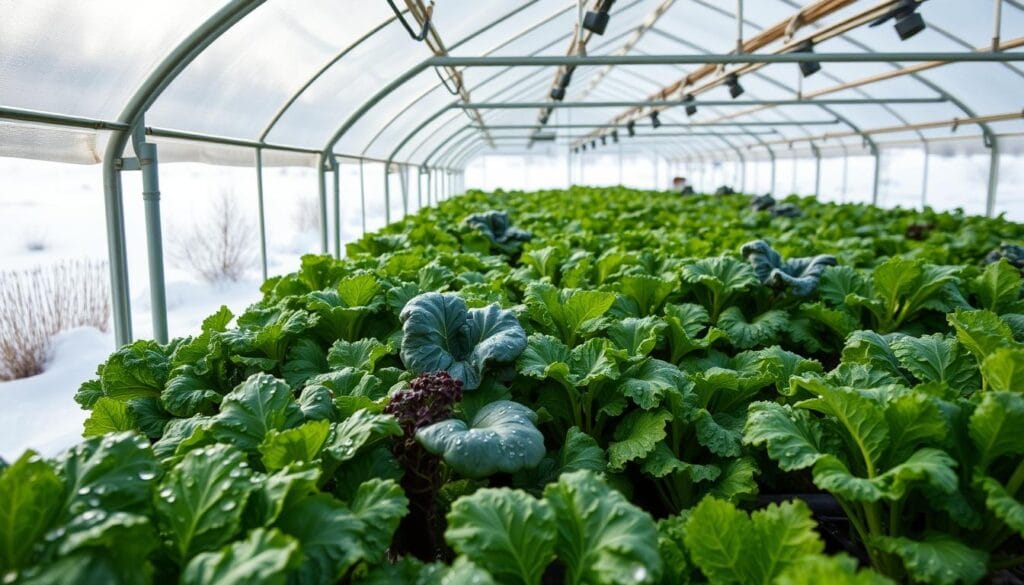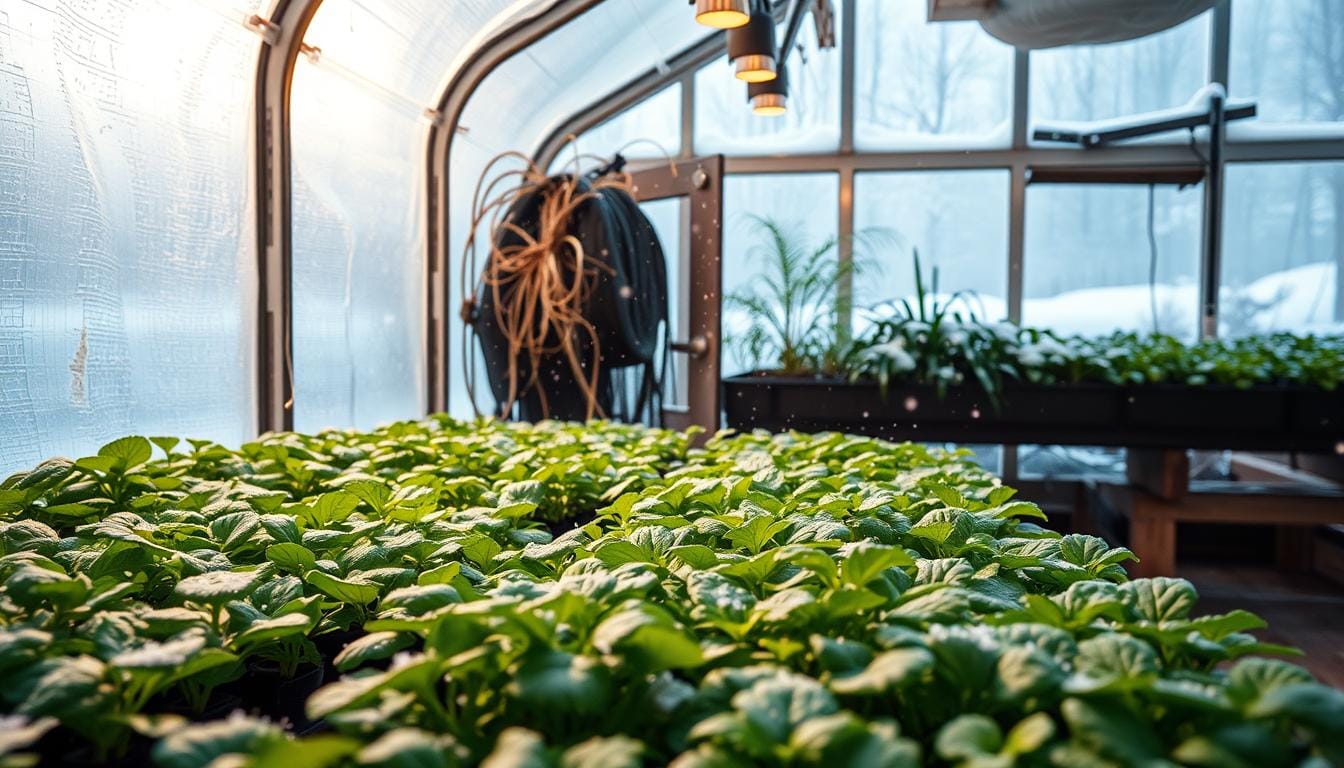Winter hydroponic growth can make fresh, vibrant produce seem like a dream. But, you can grow a thriving indoor garden even in the coldest season. Welcome to winter hydroponic gardening, where challenges become chances to explore new possibilities.
My first winter indoor gardening experience was both exciting and scary. I wanted to grow lush greenery despite the cold outside. As I learned about light, temperature, and nutrients, I grew to love these hardy plants.
Hydroponic systems deliver water and nutrients directly to roots, speeding up growth in winter. Grow tents protect your plants from harsh weather, ensuring they flourish all winter long.
Key Takeaways
- Hydroponic systems can provide up to 90% water savings compared to traditional agriculture.
- Carefully monitoring and maintaining the optimal pH levels (5.8-6.2) is crucial for hydroponic success.
- Grow tents offer complete control over the growing environment, protecting plants from pests and optimizing climate conditions.
- Hydroponic gardening eliminates the use of herbicides and pesticides, resulting in higher yields and superior-quality crops.
- Grow tents come in a range of sizes to suit different space requirements and gardening needs.
Understanding Winter Hydroponic Fundamentals
Hydroponics is an efficient and modern technique for growing plants without soil, using a nutrient-rich water solution instead. It uses water solutions full of nutrients. This method is great in winter when it’s hard to garden outside. It lets growers grow crops indoors, avoiding cold weather, less light, and changing temperatures.
Basic Principles of Hydroponics
Hydroponics means plants grow in water with nutrients. This way, plants get what they need without soil. It’s good for any space, from small balconies to big indoor gardens. This makes it perfect for growing cold weather crops all year.
Unique Challenges of Winter Growing
Winter growing with hydroponics has its own challenges. Less light and shorter days can slow plant growth. Growers need artificial lighting to help. Also, keeping the right temperature and humidity is harder in cold months.
Benefits of Indoor Cultivation
Indoor hydroponics in winter has many benefits. It keeps plants safe from bad weather and gives them steady nutrient solutions. Growers can control everything for better growth and more crops. This means faster growth, more food, and a wider variety of crops all year.
| Hydroponic System | Suitable Crops | Difficulty Level |
|---|---|---|
| Wick System | Microgreens, Herbs, Peppers | Easy |
| Water Culture System | Leaf Lettuce | Moderate |
| Ebb and Flow System | Versatile, Suitable for Many Crops | Moderate |
| Nutrient Film Technique | Leafy Greens, Herbs | Advanced |
“Hydroponics allows me to grow a variety of fresh, high-quality produce year-round, even in the depths of winter. The ability to control the growing environment is truly game-changing.”
– John Doe, Hydroponic Gardener
Essential Equipment for Winter Growing Success
To grow a thriving hydroponics system in winter, you need special equipment. This gear helps beat the cold and ensures your plants get what they need. The right tools are key to a successful winter growing season.
A grow tent is crucial for your winter hydroponics setup. These tents are light-proof and water-resistant. They keep your plants safe from the outside world. The inside of a grow tent reflects light well, making your LED grow lights more effective.
LED grow lights are a big help in winter. They give plants the light they need without too much heat. A timer makes sure your plants get the right amount of light, just like in nature.
- Grow tents for a controlled, light-proof environment
- LED grow lights to deliver efficient, full-spectrum illumination
- Timers to automate your lighting schedule
- Ventilation systems to maintain airflow and temperature
- Climate control devices to regulate temperature and humidity
You’ll also need good ventilation and climate control. These help keep your plants happy, even when it’s cold outside. Fans and monitors help you create the perfect space for your plants to grow.
| Equipment | Purpose | Key Benefits |
|---|---|---|
| Grow Tent | Provides a controlled, light-proof environment | Maximizes lighting efficiency, protects plants from outdoor conditions |
| LED Grow Lights | Delivers energy-efficient, full-spectrum illumination | Optimal for plant growth, generates less heat than traditional lights |
| Timers | Automates your lighting schedule | Ensures plants receive the right light exposure for healthy development |
| Ventilation Systems | Maintains airflow and temperature control | Promotes optimal growing conditions, prevents stagnation and condensation |
| Climate Control Devices | Regulates temperature and humidity | Creates the ideal microclimate for plants to thrive during winter |
With the right gear, you can have a thriving indoor hydroponics system all year. This means fresh, homegrown food no matter the weather. By getting the essential tools for winter growing, you’re on your way to a great harvest, even in the coldest months.
Temperature Control in Cold Weather
Keeping temperatures steady is key for indoor gardening and sustainable farming, especially in winter. In hydroponics, where plants grow in a controlled space, keeping the temperature right is vital. It helps plants grow well and avoids problems from cold.
Maintaining Optimal Root Zone Temperature
The best temperature for hydroponic water is between 65°F and 80°F (18°C and 27°C). This helps plants grow well and prevents diseases. Using hydroponic water heaters keeps the temperature stable, helping plants thrive.
Heat Management Strategies
Keeping the temperature right in hydroponics is important because plants don’t like changes in water temperature. Even a little change can stop plants from growing well. Finding the right hydroponic heater is important. It depends on the system size, the plants, and how efficient it is.
Using Temperature Monitoring Systems
Having the right water temperature is crucial for plants to absorb nutrients well. This leads to healthy plants and good yields. Choosing a heater that uses less energy helps save money and is better for the environment.
By using smart temperature control, gardeners and farmers can make sure plants grow well, even in the coldest winters.
“Balancing water temperatures in hydroponics supports strong root development and efficient nutrient absorption.”
Winter Hydroponic Gardening: Best Practices
Winter brings unique challenges to hydroponic gardening. But with the right practices, your garden can thrive. This is true for both urban farming and vertical gardening.
Keeping your system clean is key. Clean your tanks and reservoirs weekly to stop algae buildup. This helps your plants absorb nutrients better. Also, check nutrient levels and pH often to avoid problems and help your plants grow well.
- Maintain a consistent water level, ensuring the roots are submerged but not fully submerged
- Implement a 12-18 hour light schedule for your plants to support their growth
- Utilize pre-fab hydroponic systems with straightforward setup instructions for quick and easy installation
Space efficiency is important in winter gardening. They require less energy and generate less heat. Systems like AeroGarden, Click & Grow, and Gardyn can grow up to 30 plants indoors.
| System | Plant Capacity | Key Features |
|---|---|---|
| AeroGarden | 12-24 plants | Automated alerts and watering, reusable pods |
| Click & Grow | 9-27 plants | Patented “smart soil” pods, potential for mold |
| Gardyn | Up to 30 plants | Biodegradable pods, membership for smart features |
Preventing pests and keeping your garden clean is crucial. Regularly check your plants and fix any problems quickly. This way, you can enjoy a good harvest even in winter.
“Gardening activities are shown to encourage physical exercise, promote mental well-being, and provide social interaction, contributing to overall health.”
Follow these best practices to make your urban farm or vertical garden thrive in winter. You’ll have fresh produce right at your fingertips all season long.
Lighting Solutions for Shorter Days
As winter comes, we need more light for our indoor gardens. Artificial lighting is key to keep plants growing well. It helps make up for less natural light and keeps plants in sync with day and night.
LED Lighting Benefits
LED grow lights are a top pick for indoor gardens. They use less energy and give off less heat. Plus, you can adjust the light to fit what your plants need at each stage of growth.
Light Scheduling Techniques
Setting the right light schedule is important. Leafy greens like lettuce need 10-14 hours of light. Fruiting plants like tomatoes need 14-18 hours. Timers help keep the light right for your plants.
Managing Light Intensity
Getting the light just right is vital. In winter, plants might need more light. Watch for indicators such as leggy growth or yellowing leaves. Too much light can hurt plants too. Adjusting the lights or using dimmers helps keep the light perfect.
Using LED lights, scheduling light, and adjusting intensity helps your garden thrive in winter. These steps ensure a healthy and sustainable harvest all year.
Nutrient Management During Cold Months
Keeping your hydroponic system’s nutrient levels right is key for healthy plants and good harvests in winter. The basics of nutrient management stay the same, but you need to adjust for winter’s unique challenges.
Lower temperatures can make it harder for plants to take in nutrients. To help, you might need to up the nutrient solutions a bit. This guarantees that your plants receive the necessary nutrients.
It’s important to watch the electrical conductivity (EC) and pH levels of your nutrient solution closely in winter. The right EC and pH help nutrients get to your plants well. Using automated systems can make this easier and keep conditions perfect.
| Nutrient | Optimal Range for Herbs |
|---|---|
| Nitrogen (N) | 150 ppm |
| Phosphorus (P) | 31 ppm |
| Potassium (K) | 210 ppm |
Also, saving water is more important in winter. Using recirculating systems can cut down on water waste. With smart management, your plants can thrive, even when it’s cold.

“Proper nutrient management is the foundation for successful winter hydroponic gardening. By staying vigilant and making strategic adjustments, you can unlock the full potential of your indoor growing operation.”
Humidity Control and Ventilation Strategies
Keeping the right humidity is key for your indoor gardening and hydroponics system. In winter, it’s hard to control humidity because cold air makes plants sweat. This can lead to mold and mildew. To keep your plants healthy, use good humidity control and ventilation.
Managing Condensation Issues
Condensation is a big problem in winter hydroponics. Too much moisture can harm your plants and damage your setup. Use dehumidifiers to keep the air dry. Place them where humidity is highest to keep your plants happy.
Air Circulation Solutions
Good air flow is vital for humidity control. Install fans to move the air and stop it from getting stuck. This keeps moisture levels even and prevents condensation.
Humidity Monitoring Tools
Get reliable humidity tools like hygrometers to watch your hydroponics system‘s moisture. These tools give you current data to adjust your setup. Track humidity to improve your growing space.
With these strategies, you can make your winter indoor garden a success. Your plants will get the best conditions to grow well.
Cold-Weather Crop Selection Guide
As winter gets closer, urban farmers and home gardeners face a challenge. They want to keep growing food even when it’s cold. The right cold weather crops can help you succeed, whether you’re in an urban farming spot or a backyard greenhouse.
Leafy greens and herbs shine in winter hydroponic gardening. Spinach is quick, ready in 35 to 45 days. Lettuce takes a bit longer, from 30 to 70 days, depending on the type.
- Spinach: Ready to harvest in 35 to 45 days
- Lettuce: Ready to harvest in 30 to 70 days
- Arugula: Ready to harvest in 20 to 50 days
- Radishes: Ready to harvest in 30 to 70 days
- Kale: Ready to harvest in 30 to 60 days
- Turnips: Ready to harvest in 40 to 55 days
- Carrots: Ready to harvest in 50 to 70 days
- Beets: Ready to harvest in 50 to 70 days
In places like Calgary, Alberta, growers have grown Yukon Spinach in greenhouses. They direct-seeded it on September 19 and started harvesting in late October. Even when it got as cold as minus 6 degrees Celsius, the spinach thrived.
But without extra heat and light, these crops slow down. They start growing again in late February, when days get longer.
Microgreens, like pea shoots, are a fast-growing option. They can be harvested in days. This gives you a steady supply of fresh greens all winter.
Choosing the right cold weather crops and using indoor spaces can lead to a successful winter harvest. This is true for both urban farmers and home gardeners, no matter the season.

Energy Efficiency and Cost Management
Starting your winter hydroponic garden? Focus on saving energy and money. Vertical farming uses a lot of power for lights, fans, and more. This can cost a lot and harm the environment. But, you can cut down on energy and save money with green practices.
Reducing Energy Consumption
Use energy-saving lights, heaters, and pumps. Add insulation and use heat recovery to keep warmth in. Also, think about using solar panels to power your farm. This reduces the use of fossil fuels.
Cost-Effective Growing Methods
Choose hydroponics to save water. They use only 10% of the water needed for outdoor gardens. This means lower water bills. Plus, hydroponics can grow 10 times more per square foot than soil gardens, boosting your profits.
Sustainable Practices
Embrace eco-friendly practices to save money and benefit the planet. Use water recycling and renewable energy like solar or wind. This reduces your carbon footprint and attracts eco-friendly customers and investors. It makes your hydroponic garden more successful.

